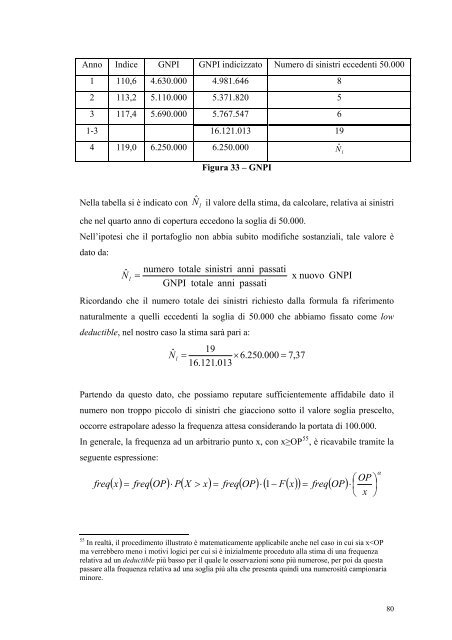(Fac-simile frontespizio tesi di laurea specialistica) - Scor
(Fac-simile frontespizio tesi di laurea specialistica) - Scor
(Fac-simile frontespizio tesi di laurea specialistica) - Scor
Create successful ePaper yourself
Turn your PDF publications into a flip-book with our unique Google optimized e-Paper software.
Anno In<strong>di</strong>ce GNPI GNPI in<strong>di</strong>cizzato Numero <strong>di</strong> sinistri eccedenti 50.000<br />
1 110,6 4.630.000 4.981.646 8<br />
2 113,2 5.110.000 5.371.820 5<br />
3 117,4 5.690.000 5.767.547 6<br />
1-3 16.121.013 19<br />
4 119,0 6.250.000 6.250.000 N l<br />
ˆ<br />
Figura 33 – GNPI<br />
Nella tabella si è in<strong>di</strong>cato con N il valore della stima, da calcolare, relativa ai sinistri<br />
ˆ<br />
che nel quarto anno <strong>di</strong> copertura eccedono la soglia <strong>di</strong> 50.000.<br />
l<br />
Nell’ipo<strong>tesi</strong> che il portafoglio non abbia subito mo<strong>di</strong>fiche sostanziali, tale valore è<br />
dato da:<br />
N ˆ<br />
l =<br />
numero totale sinistri anni passati<br />
GNPI totale anni passati<br />
x nuovo<br />
GNPI<br />
Ricordando che il numero totale dei sinistri richiesto dalla formula fa riferimento<br />
naturalmente a quelli eccedenti la soglia <strong>di</strong> 50.000 che abbiamo fissato come low<br />
deductible, nel nostro caso la stima sarà pari a:<br />
19<br />
N ˆ<br />
l = × 6.<br />
250.<br />
000 =<br />
16.<br />
121.<br />
013<br />
7,<br />
37<br />
Partendo da questo dato, che possiamo reputare sufficientemente affidabile dato il<br />
numero non troppo piccolo <strong>di</strong> sinistri che giacciono sotto il valore soglia prescelto,<br />
occorre estrapolare adesso la frequenza attesa considerando la portata <strong>di</strong> 100.000.<br />
In generale, la frequenza ad un arbitrario punto x, con x≥OP 55 , è ricavabile tramite la<br />
seguente espressione:<br />
( x)<br />
= freq(<br />
OP)<br />
⋅ P(<br />
X > x)<br />
= freq(<br />
OP)<br />
⋅(<br />
− F(<br />
x)<br />
) = freq(<br />
OP)<br />
freq 1<br />
α<br />
⎛ OP ⎞<br />
⋅⎜<br />
⎟<br />
⎝ x ⎠<br />
55 In realtà, il proce<strong>di</strong>mento illustrato è matematicamente applicabile anche nel caso in cui sia x

















